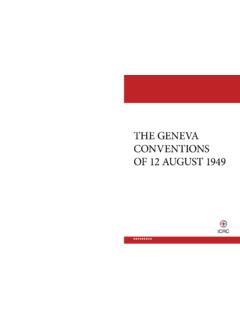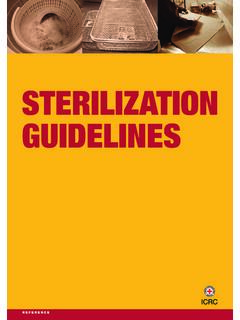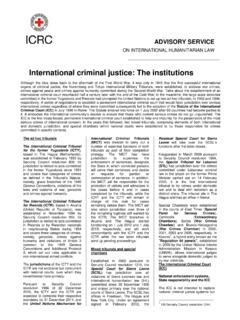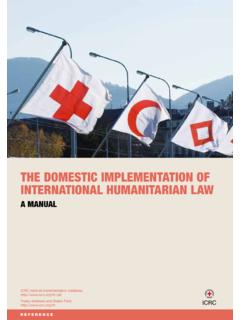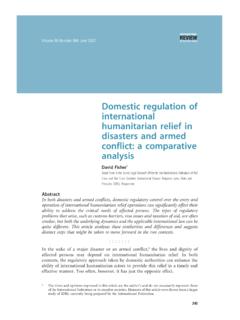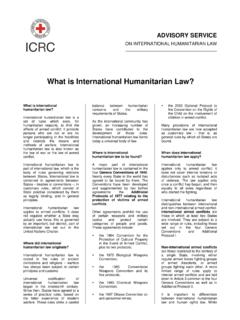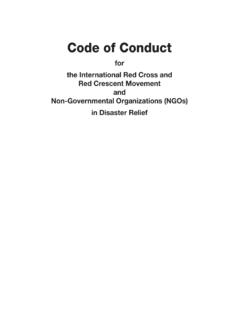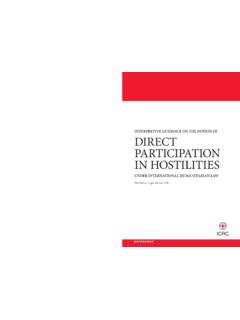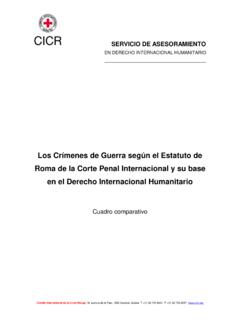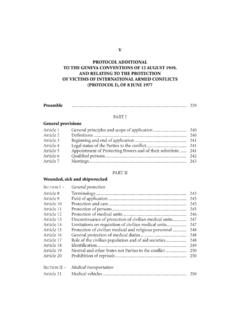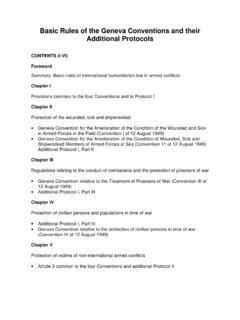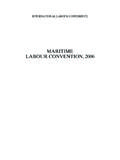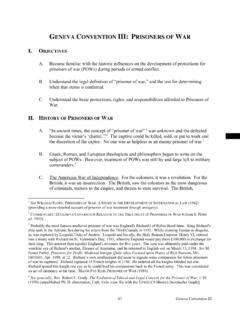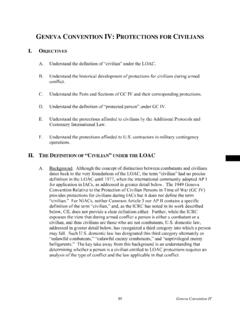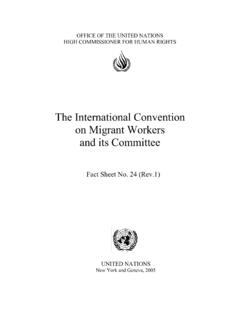Transcription of Protocols additional to the Geneva Conventions of 12 ...
1 0321/002 10,000 Protocols additional TO THE Geneva Conventions OF 12 AUGUST 1949 ICRC0321/002 10,000 Protocols additional TO THE Geneva Conventions OF 12 AUGUST 1949 ICRCPROTOCOLS additional TO THE Geneva Conventions OF 12 AUGUST 1949 This volume contains the official texts of the two Protocols additional to the Geneva Conventions of 12 August 1949, as adopted on 8 June 1977 by the Diplomatic Conference on the Reaffirmation and Development of International Humanitarian Law applicable in Armed Conflicts ( Geneva , 1974-77).
2 It also includes extracts from the Final Act of the Conference and the texts of the substantive resolutions adopted at the fourth session in Final Act, to which the two Protocols were annexed, was deposited with the Swiss Federal Council, the depositary of the 1949 I and II came into force on 7 December volume also contains the official text of the Protocol additional to the Geneva Conventions of 12 August 1949, and relating to the Adoption of an additional Distinctive Emblem (Protocol III), adopted on 8 December III came into force on 14 January 1 April 2010, 169 States had agreed to be bound by Protocol I, 165 by Protocol II and 52 by Protocol 10,000 Protocols additional TO THE Geneva Conventions OF 12 AUGUST 1949 ICRCPROTOCOLS additional TO THE Geneva Conventions OF 12 AUGUST 1949 This volume contains the official texts of the two Protocols additional to the Geneva Conventions of 12 August 1949.
3 As adopted on 8 June 1977 by the Diplomatic Conference on the Reaffirmation and Development of International Humanitarian Law applicable in Armed Conflicts ( Geneva , 1974-77). It also includes extracts from the Final Act of the Conference and the texts of the substantive resolutions adopted at the fourth session in Final Act, to which the two Protocols were annexed, was deposited with the Swiss Federal Council, the depositary of the 1949 I and II came into force on 7 December volume also contains the official text of the Protocol additional to the Geneva Conventions of 12 August 1949, and relating to the Adoption of an additional Distinctive Emblem (Protocol III)
4 , adopted on 8 December III came into force on 14 January 1 April 2010, 169 States had agreed to be bound by Protocol I, 165 by Protocol II and 52 by Protocol International Committee of the Red Cross (ICRC) is an impartial, neutral and independent organization whose exclusively humanitarian mission is to protect the lives and dignity of victims of armed conflict and other situations of violence and to provide them with assistance. The ICRC also endeavours to prevent suffering by promoting and strengthening humanitarian law and universal humanitarian principles.
5 Established in 1863, the ICRC is at the origin of the Geneva Conventions and the International Red Cross and Red Crescent Movement. It directs and coordinates the international activities conducted by the Movement in armed conflicts and other situations of International Committee of the Red Cross (ICRC) is an impartial, neutral and independent organization whose exclusively humanitarian mission is to protect the lives and dignity of victims of armed conflict and other situations of violence and to provide them with assistance. The ICRC also endeavours to prevent suffering by promoting and strengthening humanitarian law and universal humanitarian principles.
6 Established in 1863, the ICRC is at the origin of the Geneva Conventions and the International Red Cross and Red Crescent Movement. It directs and coordinates the international activities conducted by the Movement in armed conflicts and other situations of s noteUpon completion of a procedure begun in 1989, a number of amendments to Annex I to Protocol I (Regulations concerning identification) were adopted on 30 November 1993 and came into force on 1 March present volume contains the amended text of Annex 17, 18 and 19 of the 1974-77 Diplomatic Conference and the annexes thereto comprise or refer to Articles 3, 6, 7, 8, 9, 10 and 11 of the original version of Annex I.
7 These provisions are now Articles 4, 7, 8, 9, 10, 11 and 12 56 of Protocol I contains a reference to Article 16 of Annex I, which is now Article additional TO THE Geneva Conventions OF 12 AUGUST 1949 PROTOCOL additional TO THE Geneva Conventions OF 12 AUGUST 1949 1 ContentsPROTOCOL additional TO THE Geneva Conventions OF 12 AUGUST 1949, AND RELATING TO THE PROTECTION OF VICTIMS OF INTERNATIONAL ARMED CONFLICTS (PROTOCOL I), OF 8 JUNE 1977 Preamble .. 9 PART IGENERAL PROVISIONS .. 10 Article 1 General principles and scope of application.
8 10 Article 2 Definitions .. 10 Article 3 Beginning and end of application .. 11 Article 4 Legal status of the Parties to the conflict .. 11 Article 5 Appointment of Protecting Powers and of their substitute .. 11 Article 6 Qualified persons .. 13 Article 7 Meetings .. 13 PART IIWOUNDED, SICk AND SHIPWRECkED .. 13 SECTION I General protection .. 13 Article 8 Terminology .. 13 Article 9 Field of application .. 15 Article 10 Protection and care .. 16 Article 11 Protection of persons .. 16 Article 12 Protection of medical units .. 17 Article 13 Discontinuance of protection of civilian medical units.
9 17 Article 14 Limitations on requisition of civilian medical units .. 18 Article 15 Protection of civilian medical and religious personnel .. 18 Article 16 General protection of medical duties .. 19 Article 17 Role of the civilian population and of aid societies .. 19 Article 18 Identification .. 20 Article 19 Neutral and other States not Parties to the conflict .. 21 Article 20 Prohibition of reprisals .. 21 SECTION II Medical transportation .. 21 Article 21 Medical vehicles .. 212 CONTENTSA rticle 22 Hospital ships and coastal rescue craft.
10 21 Article 23 Other medical ships and craft .. 22 Article 24 Protection of medical aircraft .. 23 Article 25 Medical aircraft in areas not controlled by an adverse Party .. 23 Article 26 Medical aircraft in contact or similar zones .. 23 Article 27 Medical aircraft in areas controlled by an adverse Party .. 24 Article 28 Restrictions on operations of medical aircraft .. 24 Article 29 Notifications and agreements concerning medical aircraft .. 25 Article 30 Landing and inspection of medical aircraft .. 25 Article 31 Neutral or other States not Parties to the conflict.
